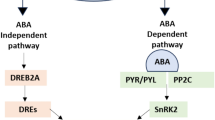Summary
48 hours after interrupting the root stele ofPisum, wound phloem initiated (proximally or distally to the wound) to reconnect the vascular stumps was found to contain some nucleate wound-sieve elements. At the elongating end of an incomplete wound-sieve tube these elements exhibit a sequence of ultrastructural changes as known from protophloem-sieve tubes. Elongation occurs by the addition of newly divided (wound-) sieve-element/companion-cell complexes. In order to dedifferentiate and assume a new specialization formerly quiescent stelar or cortical cells require at least one (mostly more) preliminary division. Companion cells are consequently obligatory sister cells to wound-sieve elements.
By reconstruction using serial sections it could be shown that wound-sieve tubes elongate bidirectionally, starting in an early activated procambial cell of the stele. The elongation is directed by the existence of plasmodesmata, preferably when lying in primary pit fields, and by the plane of preceding divisions. Thus, the developing wound-sieve tube can deviate from the damaged bundle and radiate into the cortex as soon as the plane of the preceding divisions is favourable. In the opposite direction, elongating wound-sieve tubes run parallel to pre-existing phloem traces, thus broading their base at the bundle for the deviating part of the wound-sieve tube. Frequently an individual wound-sieve tube is supplemented at the bundle by a further wound-sieve tube which is partly running parallel to it. Both sieve tubes are interlinked with sieve plates by three-poled sieve elements.
Ultrastructurally, the developmental changes of nucleate wound-sieve elements follow the known pattern. In spite of its contrasting origin and odd shape a mature wound-sieve element eventually has the same contents as regular sieve elements: sieve-element plastids, mitochondria, stacked ER and small amounts of P-protein within an electronlucent cytoplasm.
Similar content being viewed by others
References
Behnke, H.-D., 1974: Comparative ultrastructural investigations of angiosperm sieve elements: Aspects of the origin and early development of P-protein. Z. Pflanzenphysiol.74, 22–34.
—,Kiritsis, U., 1983: Ultrastructure and differentiation of sieve elements in primitive angiosperms. I.Winteraceae. Protoplasma118, 148–156.
Behnke, H.-D., Pop, L., 1981: Sieve-element plastids and crystalline P(hloem)protein inLeguminosae: Micromorphological characters as an aid to the circumscription of the family and subfamilies. In: Advances in Legume Systematics (Polhill, R. M., Raven, P. H., eds.), pp. 707–715. London: HMSO.
—,Schulz, A., 1980: Fine structure, pattern of division, and course of wound phloem inColeus blumei. Planta150, 257–365.
— —, 1983: The development of specific sieve-element plastids in wound phloem ofColeus blumei (S-type) andPisum sativum (P- type), regenerated from amyloplast-containing parenchyma cells. Protoplasma114, 125–132.
Benayoun, J., Aloni, R., Sachs, T., 1975: Regeneration around wounds and the control of vascular differentiation. Ann. Bot.39, 447–454.
Eleftheriou, E. P., Tsekos, I., 1982: Development of protophloem in roots ofAegilops comosa var.Thessalica. II. Sieve-element differentiation. Protoplasma113, 221–233.
Esau, K., Gill, R. H., 1972: Nucleus and endoplasmic reticulum in differentiating root protophloem ofNicotiana tabacum. J. Ultrastruct. Res.41, 160–175.
—,Thorsch, J., 1984: The sieve plate ofEchium (Boraginaceae): Developmental aspects and response of P-protein to protein digestion. J. Ultrastruct. Res.86, 31–45.
Eschrich, W., 1953: Beiträge zur Kenntnis der Wundsiebröhren-Entwicklung beiImpatiens holsti. Planta43, 37–74.
Hardham, A. R., McCully, M. E., 1982a: Reprogramming of cells following wounding in pea (Pisum sativum L.) roots. I. Cell division and differentiation of new vascular elements. Protoplasma112, 143–151.
— —, 1982b: Reprogramming of cells following wounding in pea (Pisum sativum L.) roots. II. The effects of caffeine and cholchicine on the development of new vascular elements. Protoplasma112, 152–166.
Kollmann, R., Dörr, I., Schulz, A., Behnke, H.-D., 1983: Funktionelle Differenzierung der Assimilatleitbahnen. Ber. dtsch. bot. Ges.96, 117–132.
—,Glockmann, C., 1985: Studies on graft unions. I. Plasmodesmata between cells of plants belonging to different unrelated taxa. Protoplasma124, 224–235.
Lane, B. P., Europa, D. L., 1965: Differential staining of ultrathin sections of Epon-embedded tissue for light microscopy. J. Histochem. Cytochem.13, 579–582.
Melaragno, J. C., Walsh, M. A., 1976: Ultrastructural features of developing sieve elements inLemna minor L.—The protoplast. Amer. J. Bot.63, 1145–1157.
Northcote, D. H., Wooding, F. B. P., 1966: Development of sieve tubes inAcer pseudoplatanus. Proc. Roy. Soc. B163, 524–537.
Rana, M. A., Gahan, P. B., 1983: A quantitative cytochemical study of determination for xylem-element formation in response to wounding in roots ofPisum sativum L. Planta157, 307–316.
Robbertse, P. J., McCully, M. E., 1979: Regeneration of vascular tissue in wounded pea roots. Planta145, 167–173.
Sachs, T., Cohen, D., 1982: Circular vessels and the control of vascular differentiation in plants. Differentiation21, 22–26.
Schulz, A., 1986: The beginning of translocation in wound phloem. In: International Conference on Phloem Transport (Cronshaw, J., ed.). New York: Alan R. Liss, Inc. (in press).
Thorsch, J., Esau, K., 1981: Ultrastructural studies of protophloem sieve elements inGossypium hirsutum. J. Ultrastruct. Res.75, 339–351.
Zee, S. Y., Chambers, T. C., 1969: Development of secondary phloem of the primary root ofPisum sativum. Aust. J. Bot.17, 199–214.
Author information
Authors and Affiliations
Rights and permissions
About this article
Cite this article
Schulz, A. Wound phloem in transition to bundle phloem in primary roots ofPisum sativum L.. Protoplasma 130, 12–26 (1986). https://doi.org/10.1007/BF01283327
Received:
Accepted:
Issue Date:
DOI: https://doi.org/10.1007/BF01283327




